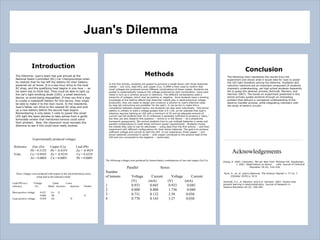Streetmanc1 06
- 1. Juan's Dilemma Acknowledgements The following voltages were produced by lemon-battery combinations of zinc and copper (Zn-Cu). Parallel Series Number of lemons Voltage Current Voltage Current (V) (mA) (V) (mA) 1 0.933 0.045 0.933 0.045 2 0.800 0.800 1.736 0.040 3 0.731 0.132 2.58 0.038 4 0.770 0.143 3.27 0.038 Conclusion The following chart represents the results from the experiment and shows what it would take for Juan to power the LED light therefore solving the dilemma. Oxidation and reduction reactions are an important component of students' chemistry understanding, yet high school students frequently fail to grasp this abstract process (Schmidt, Marohm, and Harrison 2007). The hands-on experiment presented in this article actively guides students through an interesting problem that delivers a conceptual understanding of the electron transfer process, while integrating chemistry with the study of electric circuits. Chang, R. 2007. Chemistry. 9th ed. New York: McGraw-Hill. Goodisman, J. 2001. Observations on lemon cells. Journal of Chemical Education 78 (4): 516-518. Hunt, V., et. al. Juan's Dilemma. The Science Teacher v. 77 no. 7 (October 2010) p. 52-6 Schmidt, H.J., A. Marohm, and A.G. Harrison. 2007. Factors that prevent learning in electrochemistry. Journal of Research in Science Education 44 (2): 258-283. Introduction The Dilemma- Juan's team has just arrived at the National Radio-Controlled (RC) Car Championships when he realizes that he has left the battery for their battery-powered car at home. It is a two-hour drive to the local RC shop, and the qualifying heat begins in one hour -- so his team has to think fast. They must be able to light up the car's light-emitting diode (LED), a small electronic device, to avoid being disqualified. If they can find a way to create a makeshift battery for this device, they might be able to make it to the next round. In the meantime, Juan's father can drive to the nearest RC shop and pick up a new battery before the second heat begins. Remembering it only takes 3 volts to power this small LED light the team decides to take advise from a goofy lemonade vendor that mentioned lemons could solve their problem. Now, the classroom must recreate this dilemma to see if this could have really worked. Experimentally produced voltages Reference Zinc (Zn) Copper (Cu) Lead (Pb) Pb = 0.512V Pb = -0.435V Zn = -0.492V Volts Cu = 0.956V Zn = -0.925V Cu = 0.432V Zn = 0.000V Cu = 0.000V Pb = 0.000V These voltages were produced with respect to the electrochemical series, using lead as the reference metal Lead (Pb) as a Voltage Gains Loses reference (V) Metal electrons electrons Neither Most positive voltage 0.432 Cu X 0.000 Pb X Least positive voltage -0.492 Zn X Methods In the first activity, students are guided to puncture a single lemon with three dissimilar metals -- zinc (Zn), lead (Pb), and copper (Cu). A DMM is then used to confirm that small voltages are produced across different combinations of these metals. Students are guided to systematically measure the voltage produced by each combination, using each metal in turn as a common ground or reference. The different combinations yield a hierarchy of voltages, which may be positive or negative. Once students have a working knowledge of the relative effects that dissimilar metals play in electrochemical voltage production, they are ready to design and construct a solution to Juan's dilemma (step-by-step lab instructions are available 'On the web'). It can be fun to make this a competition between student teams, but students can also work individually. One lemon battery is unlikely to yield a voltage greater than 0.9-1.0V, so we reiterate that Juan's dilemma requires lighting an LED with a minimum of 3V and an adequate amount of current (we tell students that 10-15 milliamps is generally sufficient to produce a "glow," but they can also research this question -- online or in the library -- as a preactivity homework assignment). We remind students how to use multiple batteries in series and parallel configurations to meet these minimum power requirements. Students choose the metals they wish to use for electrodes -- using data from the first activity -- and then experiment with different configurations for their lemon batteries. The goal is to produce sufficient voltage and current to light the LED. In our experience, three copper -- zinc lemon batteries connected in series -- with copper connected to the positive lead of the LED and zinc connected to the negative -- works best.
- 2. Rationale I understand the audience of this poster to be teachers or students at a science fair or maybe teachers at some kind of training or workshop. The purpose of this poster is to show others a unique way to teach high school student how batteries work and problem solving skills. This could also act as an aid for teachers to share ideas. I tried to format the poster to be easy to understand and to be a short read so if it were a âfairâ setting it would only take a few minutes to take this experiment in. I also tried to keep the all of the article's information in tact while only providing the most important information. I made sure to include information from every section of the article and by doing so it helped to retain the original structure of the article. I also found all of the table's provided in the article to be vital to the understanding of the experiment so I made sure to include these charts as well. I had several problems when using powerpoint to make this poster manly with formatting the text. I asked for a lot of help and finally found someone that was able to show me how to format the text correctly to fit the poster. It was also easier for me to write all of the information in word and then paste it into powerpoint.


